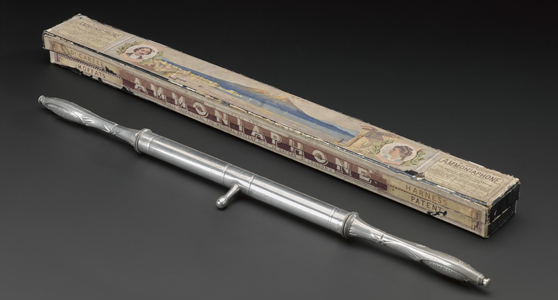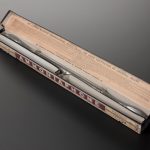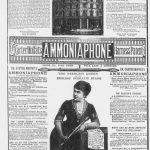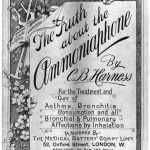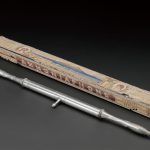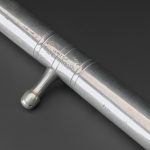Something in the Air: Dr Carter Moffat’s Ammoniaphone and the Victorian Science of Singing
Abstract
https://dx.doi.org/10.15180/170702/001In January 1885, the Glaswegian Professor of Chemistry Dr Robert Carter Moffat organised a special operatic concert at St James’s Hall, London, to which he invited around two thousand scientists and musicians. The point of this invitation concert was that all the singers used bottled air. Moffat himself appeared between the various performances, wielding his mysterious Ammoniaphone, or bottled-air machine, a long silver tube which he flourished in the faces of his audience while describing its virtues with considerable animation. The premise of the Ammoniaphone was that since Italian opera singers were known throughout the world for the beauty of their voices, it stood to reason that this must have something to do with the quality of the air they breathed. The Ammoniaphone, Moffat claimed, contained the precise chemical formula of the air in Southern Italy, and inhaling from this instrument effectively resulted in the ‘Italianization of the voice’.
Drawing on representations of the Ammoniaphone across nineteenth-century advertising and the medical and musical press, and situating these representations within the broader Victorian fascination with the supremacy of Italian opera singers, this essay offers new insight into the emergent corporeal anxieties betrayed by late nineteenth-century consumer culture, and the various methods by which the body might be continually fashioned and re-fashioned in order to produce a high-functioning social subject in a fast-paced modern society. Aggressively (not to say unscrupulously) advertised, the Ammoniaphone was marketed to vocalists, clergymen, public speakers, choirmasters, schoolmasters, parliamentarians, and enthusiastic amateurs of these vocations, with claims that it would conserve and preserve the voice, expand its range upwards and downwards, and lend it an otherwise unobtainable purity, beauty and richness. This, I will argue, was symptomatic of a broader cultural need to counter the stresses and strains of modern life, and to wreak some kind of evolutionary advantage through artificial intervention.
Keywords
Ammoniaphone, Climate Theory, Commodity Culture, Evolutionary Biology, History of Medicine, history of technology, Italian Vocal School, nineteenth century, Robert Carter Moffat
Introduction
https://dx.doi.org/10.15180/In Italy, voices have a gentle sweetness that recalls both the scent of flowers and the purity of the sky. Nature has destined this music for this climate; the one is like a reflection of the other.
In November 1884, a rather unusual concert crowd, comprised of approximately two thousand scientists and musicians, gathered at St James’s Hall in London to attend a special operatic concert organised by Dr Robert Carter Moffat, an enterprising Professor of Chemistry and Technological Lecturer in Glasgow. They had been invited to witness first-hand the effects of a wonderful new invention designed to strengthen and enrich the tones of the voice, extend its range upwards and downwards, and lend it an otherwise unobtainable purity and beauty. All the performers had reportedly used this instrument, known as the Ammoniaphone, and the concert itself was arranged by Miss Carlingford, a young vocalist who had been garnering fame for her performances in several Gilbert and Sullivan operettas, and who wished to publicly recognise the personal and professional benefits she had derived from Moffat’s invention. Dr Moffat himself appeared at the podium during a break in the performance to present the mysterious Ammoniaphone, a flute-like metallic tube about 25 inches long, with a mouthpiece in the centre and a valve at either end (see Figure 1), which, contemporaries reported, he flourished in the faces of his audience while describing its virtues with considerable animation. Moffat claimed that, because of his own strained and entirely ineffectual voice, which had always produced only ‘poor miserably squeaky things of a light tenor character’, he had been interested in improving the speaking and singing voice since his childhood (Moffat, 1885, pp 14–15). For nearly thirty years, he had been carrying out experiments in voice cultivation by chemical and electrical methods, inhaling various gases and imbibing various chemical solids and fluids in order to observe their effects. It was, however, on a professional visit to the province of Pescara in the Abruzzo region of Italy in 1874 that he experienced a revelation: there was something special and advantageous in the Italian air. Moffat never described his scientific methods, but reported that, journeying ‘from valley to valley and from plain to plain’ in the region, he conducted seventy-three analyses of the dew and air, and consistently found that both ammonia and peroxide of hydrogen were present in unusually large quantities. He visited the valley in which the great Italian tenor Antonio Giuglini was raised and found the ‘air and the dew in that lovely spot absolutely bathed in peroxide of hydrogen and free ammonia’ (1884, pp 11–12). Furthermore, he noted, throughout this region ‘the men in particular could produce those beautiful, high open tenor notes for which Giuglini was so famous’ with apparent ease (1884, p 11). It was, he therefore concluded, the inhalation of these two constituents that accounted for the well-known beauty, rich fullness, and marked superiority of the Italian vocal tones.
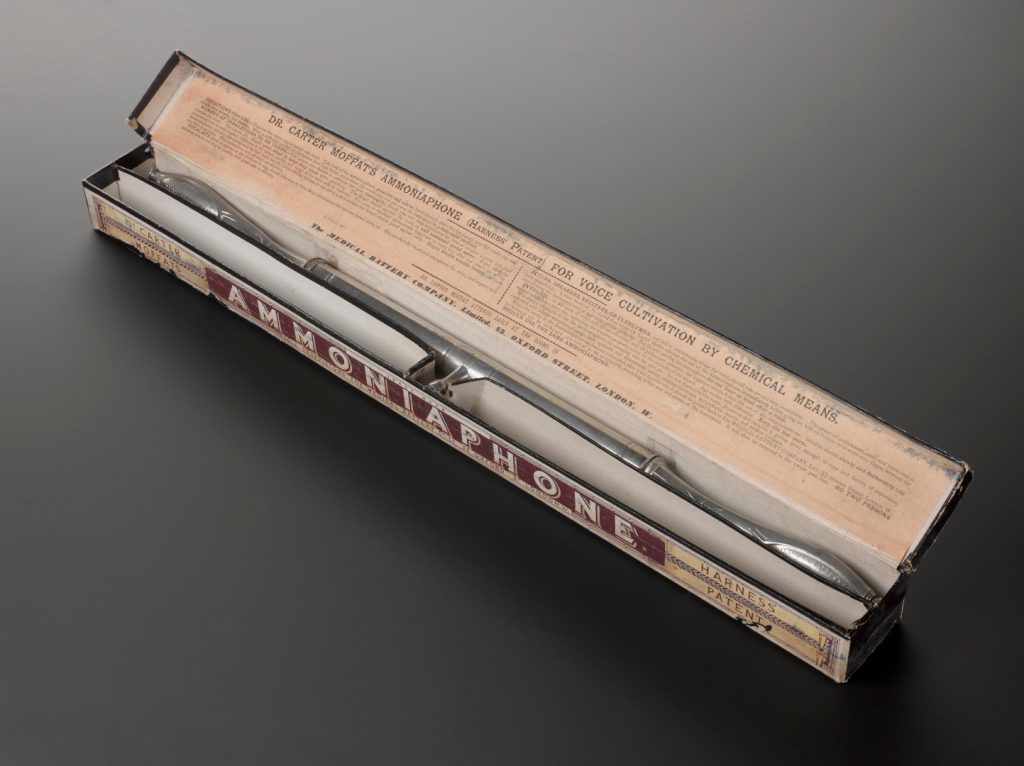
Returning to Glasgow, Moffat resigned from his appointments, set up his own laboratory, and commenced a lengthy series of experiments on himself and his own supposedly harsh tenor voice. After nine and a half years, he claimed to have perfected the art of voice cultivation by chemical means. The Ammoniaphone, Moffat explained, was filled with an absorbent material saturated with his own chemical compound of ammonia, hydrogen peroxide, and several of the fragrant perfumes also found in the Italian air. When inhaled through the vocal chords and taken into the lungs, this mixture supposedly produced the same benefits as the individual would derive from ‘drinking in the balmy air under Italian skies’ (1885c, p 127).
The benefits of those balmy Italian skies had long been debated in British medical circles, as anxieties about the stresses and strains of life and the heightened levels of environmental pollution brought about by the new conditions of technological and industrial modernity were being expressed by medics, sanitary reformers, and more general social commentators. Such fears prompted a concomitant growth in travel for health throughout the nineteenth century, which was aided by the coming of the railways. In his landmark study of The Sanative Influence of Climate, published in 1841, the royal physician Sir James Clarke had advised that the removal of English invalids to the mild climates of southern Europe could aid in the treatment of a range of diseases. The benefits of such a climate were both physiological and psychological, as he insisted that ‘new scenes and the objects of interest, with which the South of Europe, more especially Italy, abounds, exert a direct and beneficial influence also on the mental constitution (Clarke, 1841, p 10). In such a climate, the Ammoniaphone offered a more efficient and a much cheaper alternative than the widespread practice of travel to spas and resorts along the British coast and the Continent in search of fresh air and an improved climate.[1]
In effect, amidst a broader nineteenth-century scientific and cultural quest for the sanative qualities of various micro-climates across Europe, Moffat had bottled healthy, restorative air and made it available in England for the price of 21 shillings (with subsequent fees to recharge the instrument once it was exhausted). This, Moffat declared in a series of lectures, public concerts, demonstrations, and advertisements throughout England and Scotland, was highly concentrated ‘Italianized air’ in an extremely portable condition. Not only would it immediately relieve the kinds of chest and throat affections that were driving English invalids to healthier climes, but the previously unsurpassable talent of the great Italian opera singers was now literally within the grasp of the aspiring British vocalist. During his demonstrations, volunteers were invited on stage and asked to speak in their natural voice before inhaling the artificial air in order to call attention to the fact that after using the Ammoniaphone, their voices were immediately and dramatically improved in tone. Directions for optimal use of the product were included in a rather lengthy pamphlet distributed at the concert and later included for free with every Ammoniaphone purchase. According to Moffat, two very slow but very deep inhalations of Italian air taken from the Ammoniaphone daily, coupled with an effective series of vocal exercises – speaking aloud in large deep tones if one were an orator, or practising the voice in well-sustained, round notes if one were a singer – would thoroughly cultivate and ‘Italianize’ the voice (Moffat, 1885, p 1). Within a year, Moffat claimed, the voice would be permanently improved, and it would become as strong, rich and mellow as Moffat’s own now full and powerful tenor voice, which had extended to three octaves thanks to daily use of the Ammoniaphone – and, it must be added, his daily vocal exercises.
Moffat licensed the production of the Ammoniaphone to the Medical Battery Company, which, under the proprietorship of Cornelius Bennett Harness managed an aggressive advertising campaign that targeted not only British vocalists but also clergymen, public speakers, actors, choirmasters, schoolmasters, parliamentarians, and enthusiastic amateurs of these vocations. They also claimed a plethora of medical applications for the device, which was purportedly invaluable for the treatment of colds, coughs, asthma, aphonia, bronchitis, consumptions, loss of voice, deafness, and all affections of the throat and chest. The company availed itself of the recent growth of an efficient and affordable postal service across Britain in order to distribute its advertising material widely and to enable the possibility of ordering by mail. Drawing upon this vast modern network, the company also solicited thousands of testimonials from public figures, frequently sending famous doctors, singers, actors, and politicians a free Ammoniaphone without request before writing periodically to offer to replenish its contents and then unashamedly publishing their responses in a series of adverts. These responses are revealing. Occasionally, as in the below advert of 1885 (see Figure 2), some writers do acknowledge the potential benefits of using the Ammoniaphone, while figures like Her Royal Highness the Princess of Wales, and Her Royal Highness Princess Louise are noted merely as users of the Ammoniaphone, as they presumably had only acknowledged the receipt of their free instruments from the company. The Prime Minister William Gladstone, who is enthusiastically described in the advert as ‘England’s silver-toned premier’, is claimed as an avid user of the Ammoniaphone despite the fact that Gladstone’s secretary, H W Primrose had only sent the rather curt and dismissive response that ‘Mr Gladstone has received your letter of the 9th, and desires me to thank you for your kind offer to recharge his Ammoniaphone. When exhausted he will bear it in mind’ (1885, p 212). The clear implication here is that Gladstone had not used, nor did he have any interest in, the Ammoniaphone. Nonetheless, his name was firmly associated with the device in a range of subsequent advertisements, as the Medical Battery Company used the supposed support of figures in authority to adapt its sales pitches and target the nervous bodies and medical anxieties emanating from the musical and political professions.
Carter Moffat’s invention was, unsurprisingly, rather short-lived. In 1893, after a series of disturbing exposés in the popular press, the Medical Battery Company was indicted for fraud and by 1895 the company was bankrupt. At this point, the Ammoniaphone faded into obscurity, and has been largely dismissed as an erstwhile craze in a new culture of mass-marketed medical commodities and services, and an interesting footnote in the history of Victorian quack advertising. Nonetheless, Harness’s unscrupulous advertising campaign, this essay will argue, reflected a broader cultural need to counter the stresses and strains of modern life, and it provides new insights into the professional and the material anxieties of singers and orators in the late nineteenth century. Users of the Ammoniaphone ultimately sought to wreak some kind of social or evolutionary advantage by way of artificial intervention in the art of voice cultivation. Within the late Victorian contexts of consumerism, climate theory, and evolutionary biology, the Ammoniaphone promised an exciting opportunity to expand upon the natural limitations of the (specifically British) body and the capabilities of its lungs and vocal cords, and to realise within Britain the hitherto racial peculiarities of the Italian voice. In so doing, it both exposed and eagerly capitalised on emergent corporeal anxieties within late nineteenth-century consumer culture, while opportunistically proposing a new method by which the human body and voice might be fashioned and re-fashioned in order to produce high-functioning and culturally sophisticated musical subjects in a fast-paced modern society.
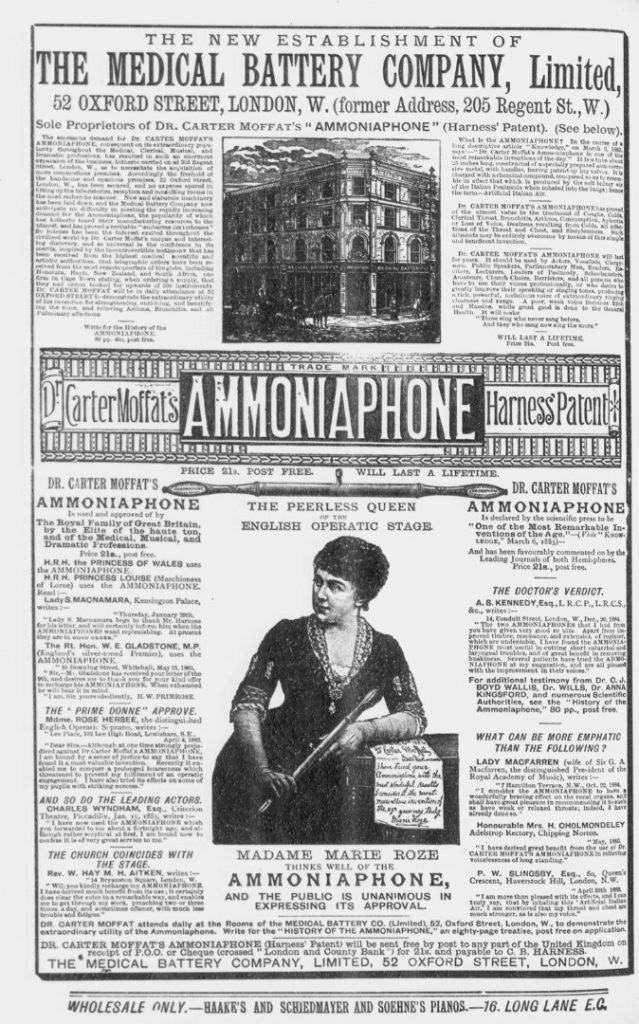
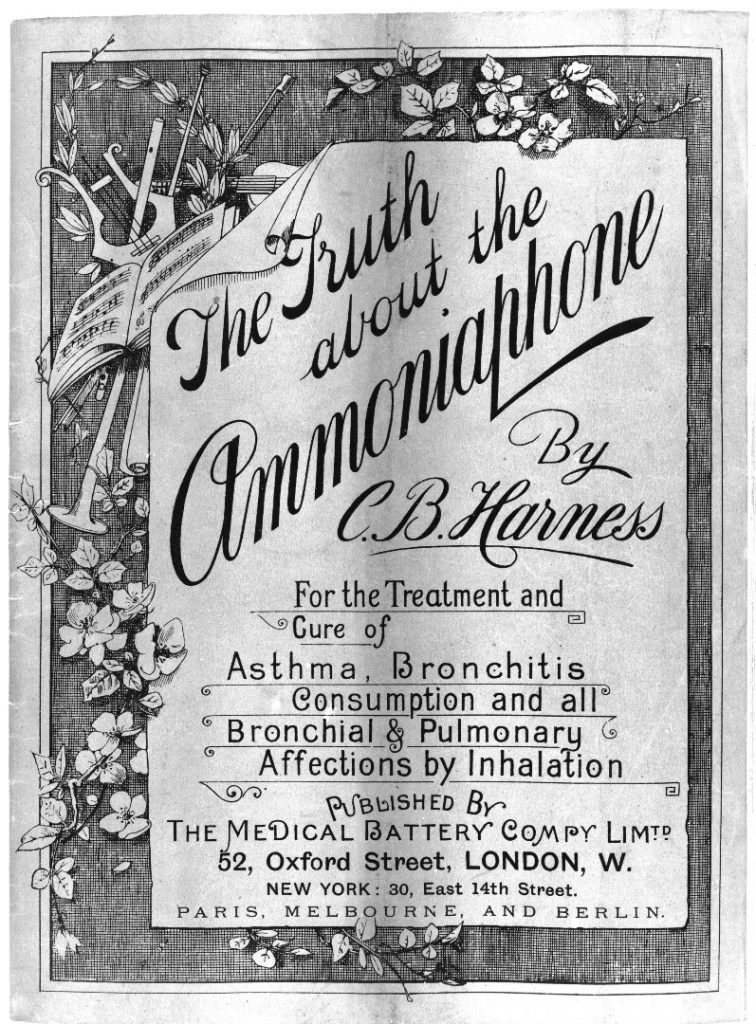
The origins of the Italian ‘Cradle of Song’
https://dx.doi.org/10.15180/170702/002The central premise of Moffat’s Ammoniaphone – that, in the words of the Magazine of Music, ‘balmy Italian air’ could be used to ‘make Saxon croakers sing like southern nightingales’ – was ‘delusively simple’, and ‘in itself a temptation to the scoffer’ (1885a, p 34). It nonetheless capitalised upon the widely perceived superiority of Italian vocal tones as a musical ideal within the operatic profession. According to the Victorian meteorologist Thomas Gilbert Bowick, Italy had ‘longed been famed as the cradle of song and the birthplace of many of our sweetest singers and grandest musicians’ (Bowick, 1884, p 76).[2] The great superiority ‘both in execution and numbers of the singers of the Schools of Italy over the rest of Europe’ was explicitly noted in the Encyclopaedia Metropolitana; Or, Universal Dictionary of Knowledge in 1845 (although, like many others, the author noted that this had been somewhat in decline in recent decades) and it was a sentiment that was echoed across the musical and general press (Gwilt, 1845, p 712). As Richard Taruskin has shown in his detailed study of music in the nineteenth century, since the rise of German instrumental music, ‘Italian musicians were happy to divide the musical world into spheres of influence: the vocal, where their superiority was unassailable (and which they regarded as the higher sphere as it was one that the human organism could produce “naturally”, without mediation), and the instrumental)’ to which the German musicians were welcome (Taruskin, 2009, p 618). Italy was regarded, above all, as a nation redolent in melodic charm. With a marked preference for melody and rhythm over harmony, the Italians, declared the Hungarian baritone Albert Bach in a lecture at the Edinburgh Music Hall in 1882, were ‘before other nations endowed with a lively sense of form and colour, of symmetry and beauty, and especially, with a sense of beautiful sound’ (Bach, 1883, p 224). The renowned Hungarian composer and virtuoso musician Franz Liszt had also reputedly noted that just ‘as esprit is said to hover about the streets in Paris, so in Italy happily invented melodies are, so to speak, in the air; they insinuate themselves incidentally, and pleasingly coax the ear’ (Bach, 1883, p 226). Music and the bountiful Italian atmosphere were equally synonymous in other cultural forms, as Phyllis Weliver’s compelling discussion of the influence of climate on racial development, language, and musical semiotics in the works of the English novelist George Meredith has demonstrated (Weliver, 2006, pp 83–109). In his ‘Fra Lippo Lippi’ (1855), the English poet Robert Browning similarly presented Italy as a dynamic, lively, and artistic nation where, when the poem’s speaker opens his window, the very air is infused with ‘a sweep of lute strings, laughs, and whifts of song’ (Browning, 2007, p 630). The association between the nation of Italy and the heights of musical beauty was undoubtedly profound in the popular consciousness, and the Italian air was understood to resonate with the beautiful melodies of its people. The precise location of that musical talent, however, be it atmospheric, meteorological, cultural, social, or biological, was a matter for ongoing debate.
Moffat was convinced that there was something peculiar to the air of Italy that accounted for the superiority of Italian vocal tones, and his views were enthusiastically endorsed by Bowick, a Fellow of the Royal Meteorological Society who wrote in his essay of 1884 that in Italy, the ‘balmy perfume-laden air, the lovely autumnal tints of grassy slopes, the foliage of the olive and the broad palmate leaf of the vine all combine in appealing to the student of Nature, of Science, and of Art.’ The Ammoniaphone was, for Bowick at least, the material embodiment of that inspirational atmosphere, and one had simply to inhale its essence so that, ‘by means of [Moffat’s] Chemical Science we are brought into a Fairy land of which no one knows the extent’ (Bowick, 1884, p 79). Its effects were, in this paradigm, akin to magic in their defiance of biologically imposed limitations. The fact that the application for a patent for the Ammoniaphone was made by ‘Robert Carter Moffat, chemist, and Thomas Gilbert Bowick, manufacturer’ did, of course, rather undercut the value of his praise, and many musicians, scientists and medical professionals with an interest in music remained highly sceptical (Browne, 1884, p 21). In November 1884, the editors of the Tonic Sol-Fa Reporter noted that several correspondents had already written to solicit the magazine’s opinion on the Ammoniaphone, and ‘we can only say that we tried it the other day, and that the inhalation had not the slightest effect on our voice’ (1884a, p 383). One surgeon’s letter to the editor of the Lancet in February 1884 raised two objections to Moffat’s theory: first, that English pupils studying in Italy did not experience the remarkable effects which Moffat claimed for Italian air, and secondly, that Italian vocalists in England did not lose their vocal superiority when removed from the influence of their supposedly ‘musical atmosphere’ (White, 1884, p 327). Dr Andrew Wilson, quoting this letter in his magazine Health, noted that ‘this looks like sensible criticism, and suggests that, after all, race-peculiarity, and not peroxide of hydrogen, lies at the root of Italian purity of song’ (Williams, 1884, p 405). The editors of the Magazine of Music concurred that beyond the vocal mechanism itself lay the Italian tendency to song, which was a geographical and a ‘racial phenomenon’ that required the broader analysis of a ‘mass of carefully collated facts’ by a sociologist like Herbert Spencer, and could not be explained by ‘mere analysis of atmospheres’ (1885a, p 34).
By referencing Spencer here, the magazine’s editors are deliberately seeking to undercut the notion that superior singing is merely the result of atmospheric influences by alluding to increasingly popular Victorian debates about the origins and the evolution of music, and thus implying that there are rather more complex biological and sociological factors at work than can be captured in a simple metal tube. In contrast to Charles Darwin’s earlier claims that human ancestors had uttered musical sounds before they had acquired powers of articulate speech, Herbert Spencer’s controversial 1857 article, ‘The Origin and Function of Music’, had rigorously set forth the principle that music’s origins lay in speech, and more specially, in the primitive language of human emotions. Spencer’s central premise was that ‘there is a physiological relation between feeling and vocal sounds; that all the modifications of voice expressive of feeling are the direct results of this physiological relationship’ (Spencer, 1857, p 49). That is, vocal sounds originally occurred through the agency of the human muscles as they contracted and relaxed in accordance with the sensations of pleasure or pain, releasing sounds whose pitch, timbre, and intervals varied in response to the emotional experiences that prompted them.[3] According to Spencer, then, music was an extension of natural physiological phenomena, and less evolved races therefore produced less evolved and far more basic music:
That music is a product of civilisation is manifest: for though some of the lowest savages have their dance-chants, these are of a kind scarcely to be signified by the title musical: at most they supply but the vaguest rudiment of music so properly called.
Spencer, 1857, p 69
Employing Spencer’s argument in response to Moffat’s claims provided a strident rebuttal of the very conception of the Ammoniaphone. A simple chemical formula for the improvement of the voice could not bestow the kind of lyrical impulse and highly evolved aesthetic sensitivity required to produce great music. Albert Bach later elaborated upon this concept in his lectures in Edinburgh, declaring that ‘Orientals sing no better when they live in our climate. They are wanting in culture and taste, otherwise they might sing with as clear and beautiful a tone as the Italian’ (Bach, 1883, p 207). He went on to draw a comparison between the infant-like, rudimentary singing of ‘uncivilised people’ and the ‘taste for music’ which is evidenced in early childhood before the ‘power of attention to words’. ‘Men in an uncivilised state’, Bach insisted, ‘do not sing as civilised Europeans do: even in the best climate they will roar’ (Bach, 1883, p 209). It was therefore of the utmost importance that the singer continually strive after intellectual refinement through the study of classical works and intercourse with people of great culture and character, for ‘the vocal organ, the larynx, cannot express anything not already realised in the mind’ (Bach, 1883, p 214).
In Bach’s paradigm, a cultured voice, as opposed to the utterances of that organ in its natural state, was the result of sophisticated intellectual impulses aided by the imagination. Climate, however, was generally understood to affect the richness and softness of the vocal tones of those already civilised, intellectual and emotionally mature European peoples in various ways. Mild climates allowed men and women to spend a greater amount of time outdoors, where, as the American minister and educator Theodore Emanuel Schmauk argued in his 1890 study of The Voice in Speech and Song, their voices were not liable to be damaged by raw and excessively cold external atmospheres or the corresponding overheated and dry interiors. In such an environment, they might constantly exercise their vocal cords and perfect their vocal tones. In Schmauk’s view, the warm air of the Mediterranean, rather than the chemicals contained within it, was a major contributor both to the national character and lifestyle:
The influence of climate, through personality, upon the voice, is somewhat similar to the influences of climate, through the personality of the composer, upon the tones of melody. In warm climates we may expect the voice to be expressive of languor and love, of sweet and tender melancholy. In cold climates we may look for notes of storm, and ruggedness and battle and conquest. In temperate climes, there should be life and grace. The Frenchman’s tones should be short, piquant, airy and gay. The German’s, broad, slow, reverential. The Italian’s, voluptuous and melodic. The Englishman’s, positive, stubborn, formal.
(Schmauk, 1890), pp 99–100
Albert Bach, too, similarly theorised that the warm climate and extended periods of time outdoors encouraged Italians to open their mouths more frequently and more widely than, for example, many inhabitants of England and Scotland, where cold, damp air induced a habitual closure of the mouth and rendered the tone of the voice close and obscure. A warm environment also, Bach noted, naturally influenced choices of food and drink, allowing Italians to live on a mainly vegetarian diet without the need for strong drink (which was damaging to the vocal cords) to artificially excite warmth. Moreover, the Italian climate created rich soil ‘yielding everything in great profusion with but little labour, that materially contributes towards the formation of the national character’ by fostering the supposedly famous dolce far niente, the ‘sweet doing-nothing’, of the Italian race who, free from the exhausting demands typically made of the labourer in northern climes, might readily conceive the notion that they ‘may exist for something better than for spending his life in constant drudgery and a kind of torment’ (Bach, 1883, pp 220–221). Such freedoms while surrounded by the ‘serene deep-blue sky, the magnificent charming tints of the landscape, the striking outlines of her mountain-ranges […] and her lovely luxuriant valleys’, which were understood to everywhere surround the Italian citizen, must necessarily exercise a beneficent influence upon both body and mind, thereby fostering that elated and passionate engagement with life that Bach believed defined the Italian character (Bach, 1883, p 222). Ultimately, Bach declared, due to the good fortune of residing within a temperate climate and enchanting landscape, ‘people so demonstrative as the Italians have at most hours of the day something at heart that would fain be out’ (Bach, 1883, p 222). Music offered an ideal medium for which to release this passion.
Interestingly, in 1885, as part of their marketing campaign, the Medical Battery Company published a song by Alfred Benjamin Allen and Percy G Moccata entitled ‘The Lost Voice: A Refrain on Dr Carter Moffat’s Ammoniaphone’, which drew upon these same associations between Italy, music, a passionate engagement with life, and the need to express that passion. In this song, a lovesick young man has lost his voice and is therefore unable to tell his beloved that his heart belongs to her. There is, however, some cause for hope:
Ah! Well for him and for the fair,
He’d heard that pure Italian air
Might be inhal’d, imparting tone
Thro’ Moffat’s fam’d Ammoniaphone!(Allen and Moccata, 1885), p 4
The young man purchases the device and upon using it, he regains his voice and immediately proposes to the young woman ‘in such tones’ that she immediately accepts his suit. The song then crescendos to a jubilant final refrain:
Ten thousand times be bless’d the sage,
Great benefactor of the age!
Restorer of his vocal tone:
Inventor of th’ Ammoniaphone!Allen and Moccata, 1885, pp 6–7
It seems that not only did the Ammoniaphone provide a simple means of achieving the tones of an Italian opera singer, but, in the context of this advertising, it was also a potential source of requited love and of that passionate, demonstrative personality supposedly characteristic of the warm-blooded Italian race. The Ammoniaphone transformed that personality and its associated lifestyle into an easily attainable scientific and medical commodity. Good health and sonorous voices were simply products to be purchased like any other.
Talisman or training?
https://dx.doi.org/10.15180/170702/003The overt commercialisation of Carter Moffat’s Ammoniaphone situated his invention within the broad host
of supposedly wonderful elixirs, newly patented pills, and electrical appliances that occupied the
expanding and commercially competitive market of medical commodities in the latter decades of the century, designed to soothe the sufferings of the modern populace. Although people had clearly long been nervous and suffered from various forms of exhaustion, the notion of ‘being modern’ was, in this period, increasingly linked to the nervous system and to the excessive levels of strain and stimulation that the nerves were supposedly being subjected to by industrial modernity. In his brief article entitled ‘Neurasthenia, or Nervous Exhaustion’, published in the Boston Medical and Surgical Journal in 1869, the New York physician and early neurologist George Miller Beard insisted upon the status of neurasthenia, or nervous collapse, not simply as a general condition of modern life, but as a distinct and new disease with characteristic symptoms that was induced by that life. Other medical works, such as Benjamin Ward Richardson’s Diseases of Modern Life (1876) lent further authority to such perception, outlining new and diverse diseases produced by the conditions of modernity. Bolstered by prevailing medical orthodoxies, a host of individuals and companies eagerly capitalised on this cult of nervous valetudinarianism. Popular tonics, often containing powerful narcotics and stimulants, were patented, marketed, and experimented with as a means of countering nervous exhaustion. The discovery of the major alkaloids in the early decades of the nineteenth century had introduced a new class of therapeutic agents – including morphine, quinine, strychnine, and opium – to the field of experimental pharmacology, and this expanded throughout the century to include chloral hydrate, the bromides, and barbiturates. Bolstered by prevailing medical orthodoxies which emphasised the value of strengthening the nervous system and restoring firmness and vigour to collapsed nerves, popular tonics, often containing powerful narcotics and stimulants, were patented and publicly embraced as a means of countering exhaustion, ‘sold behind every counter’, as T Clifford Allbutt observed in 1895, as tonics for the diverse conditions of nervous debility that he insisted were replacing complaints of the liver as the new fashionable diseases of the day. It was a popular medical and cultural maxim, Allbutt lamented, that nervous maladies and the modern experience, ‘the fretfulness, the melancholy, the unrest due to living at high pressure’, were becoming ‘inextricably intertwined’, and all the large cities were filling relentlessly with neurotics, neurasthenics, and hysterics, accompanied by ‘nerve-specialists, baths, electric-machines, and massages multiplying daily for their use’ (Allbutt, 1895, p 217).[4]
Like those products that had captured the cultural imagination by promising to effect some sort of internal alteration and physical improvement to the body, Moffat’s Ammoniaphone would supposedly transform the human voice by chemical means. It targeted the ambitious singer, the nervous orator, and the overworked public speaker, and it offered them a material, critical advantage within highly competitive and physically demanding professions. After only a few deep breaths, Moffat promised, ‘Singing becomes warbling, so easy is it, public speaking becomes simplicity itself, and nervousness or stage fright disappear’ (Moffat, 1885, p 23). One would deliver a faultless performance in spite of a highly-strung artistic temperament. It was these kinds of promises, the editors of the Magazine of Music shrewdly observed that ‘called in the imagination of the user of the Ammoniaphone to aid its physiological effect’ and exerted a potent influence upon a nervous temperament (1885a, p 34). In other words, the perceived medical benefits of the Ammoniaphone may produce a placebo effect by inculcating a sense of confidence in the singer that, without any tangible physiological alterations, could nonetheless improve his or her performance.[5]
These kinds of placebos were, it seems, extremely popular amongst the musical profession. In his study of The Hygiene of the Vocal Organs: A Practical Handbook for Singers and Speakers (1886), the eminent physician and laryngologist Sir Morrell Mackenzie observed that alongside the use of tonics, stimulants, or sedatives as a means of ensuring a triumphant performance from an artist who might otherwise have broken down from mere nervousness, ‘all singers and many speakers have their pet nostrum’ (Mackenzie, 1886, p 114). These latter substances, credited by individual singers with extraordinary qualities in clearing, strengthening, enriching, or in some way improving their voice were, according to Mackenzie, generally little more than fads. However, they had a virtue of their own which he insisted it was prudent for the practical adviser to recognise:
Great is the power of the imagination, and if a man fancies that a thing does him good, it is no doubt often really beneficial to him; so in medicine the wisest counsellors are they who adapt their measures to things are they are, not as they perhaps ought to be. […] If a man is deprived of an aid which he believes to be necessary, he is likely enough to fail, owing to that very cause. I many remind my readers of Scott’s early observation of the magical influence of a waistcoat-button upon a schoolfellow’s memory. The utility of many things which vocalists deem necessary for the well-being of their throats is of much the same kind as that button […] Therefore as long as I do not know a thing to be actually injurious, directly or indirectly, I recommend vocalists to take whatever they suppose to be helpful to them.
Mackenzie, 1886, pp 114–115
Mackenzie then proceeds in his essay to identify various substances commonly used by celebrated vocalists for the benefit of their voices, ranging from champagne and claret to coffee, lemonade, apple, pears, leeks, cold beef, sardines, and raw eggs. In instances of dryness or prickling sensations in the throat, he recommends the singer take cocaine in the form of soft lozenges for immediate relief. He takes violent exception, however, to the use of both cayenne lozenges and Carter Moffat’s Ammoniaphone, as he deems them violent irritants. The Ammoniaphone, despite its being suddenly presented to the world ‘as a talisman only comparable to the magic rings and lamps of Oriental fiction’, is, Mackenzie declares, like so many nostrums for vocalists, an irrational medication (Mackenzie, 1886, p 118). Having conducted several of his own tests with the Ammoniaphone on several individuals, he has determined that, divested of its hyperbolic promises and its powerful effects on the imagination, it is ‘simply a form of “dry inhaler” charged with a volatile preparation of doubtful utility’ that is potentially damaging to the voice (Mackenzie, 1886, p 120).
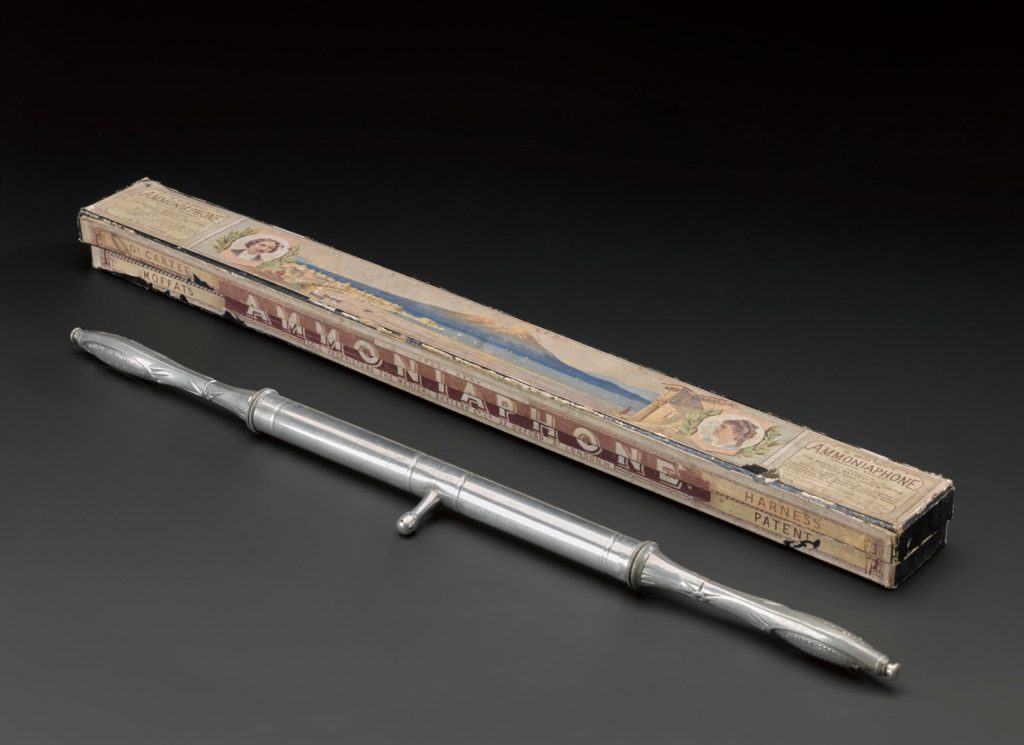
Lennox Browne, a surgeon who served as assistant to Morrell Mackenzie at the hospital for diseases of the throat in Golden Square before founding the central London Ear, Nose, and Throat hospital in 1874, was even more outspoken in declaring the Ammoniaphone to likely be of very great and lasting injury to the voice and throat. In his 1884 lecture to the Society for the Encouragement of the Fine Arts, which was later published in essay form, Browne declared that it was his duty as a scientist to consider the claims made by Moffat carefully and rigorously because they had been advocated ‘as if from a scientific viewpoint, and by some who at first sight appear to have scientific pretensions’ (Browne, 1884, p 21). During his lecture, Browne undertook a series of experiments on a vial of Moffat’s solution, which had been supplied by Moffat himself. These tests, which he said had been confirmed by two eminent chemists, demonstrated that the mixture contained a large amount of free caustic ammonia, a proportion of peppermint, and a proportion of treacle or some other saccharine medium. Advertising material for the Ammoniaphone had cited recent work undertaken by ‘one of the greatest hygienic authorities of the century’, Sir Benjamin Ward Richardson, on the potential therapeutic value of peroxide of hydrogen in practical medicine in order to demonstrate the medical validity of Moffat’s invention (Moffat, 1885, p 25). Peroxide of hydrogen was still a relatively new substance, having been first produced by Louis Jacque Thénard in 1818. Richardson had reported on his own researches in this field in October 1860, offering very tentative conclusions that as an antidote to the alkaloidal poisons, as an external application to decomposing sores, and an internal remedy in fever, as well as in diabetes, peroxide of hydrogen might be carefully administered with some promise of success. He later elaborated on its efficacy as a medicine which promotes glandular secretion in the Medical Times and Gazette in 1868.[6] Despite these new medical applications of the substance and however much peroxide of hydrogen the inventor may have originally put into his preparation, Browne declared, his own experiments demonstrated that it had all very quickly disappeared. This, Browne posited, may be a consequence of its combination with the ammonia or with the organic saccharine medium in which it was suspended, for ‘either or both are sufficient to quickly destroy its existence’ (Browne, 1884, p 25). It is, in fact, a very unstable gas, especially in the presence of an alkali like ammonia. Richardson himself had also commented on the difficulties involved in the manufacture of peroxide of hydrogen, and cited it as ‘a curious fact’ that ammonia in vapour or solution possessed a ‘neutralizing property’ when brought into contact with this gas (Richardson, 1860, p 390). Despite its being advertised as sufficient without renewal for a year’s use, any watery solution like Moffat’s containing peroxide of hydrogen could not, Browne insisted, give off any appreciable amount of that vapour even at the end of a single day. Setting aside any health benefits that peroxide of hydrogen may or may not produce as now irrelevant to the question of the efficacy of Moffat’s Ammoniaphone, Browne moved on the effects of the caustic ammonia. This element, largely the product of putrefaction and decay, was declared to be a ‘highly irritant and poisonous gas, extinguishing flame, and therefore analogously destructive to life’ (Browne, 1884, p 25). Nonetheless, having determined to give the Ammoniaphone a fair trial, Browne’s colleague Mr Behnke experimented with using the Ammoniaphone on his students according to Moffat’s own directions but in a few days had to discontinue the experiment because it produced a frightening degree of relaxation of the throat. Like Mackenzie, Browne ultimately declared the Ammoniaphone to be an injurious device akin to the use of cayenne pepper lozenges and all other irritants that acted as temporary stimulants to the resonator of the voice. ‘Since all stimulation implies reaction,’ he concluded, ‘artificial bracing such as I have indicated must carry its punishment of reactionary relaxation’ (Browne, 1884, p 26).
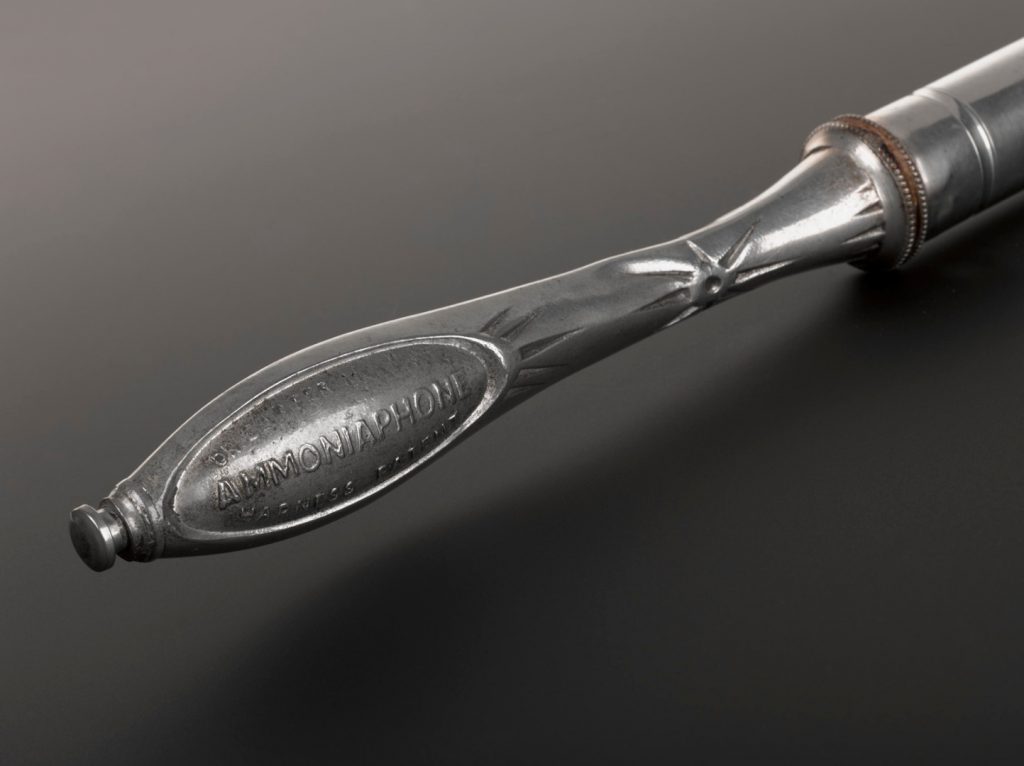
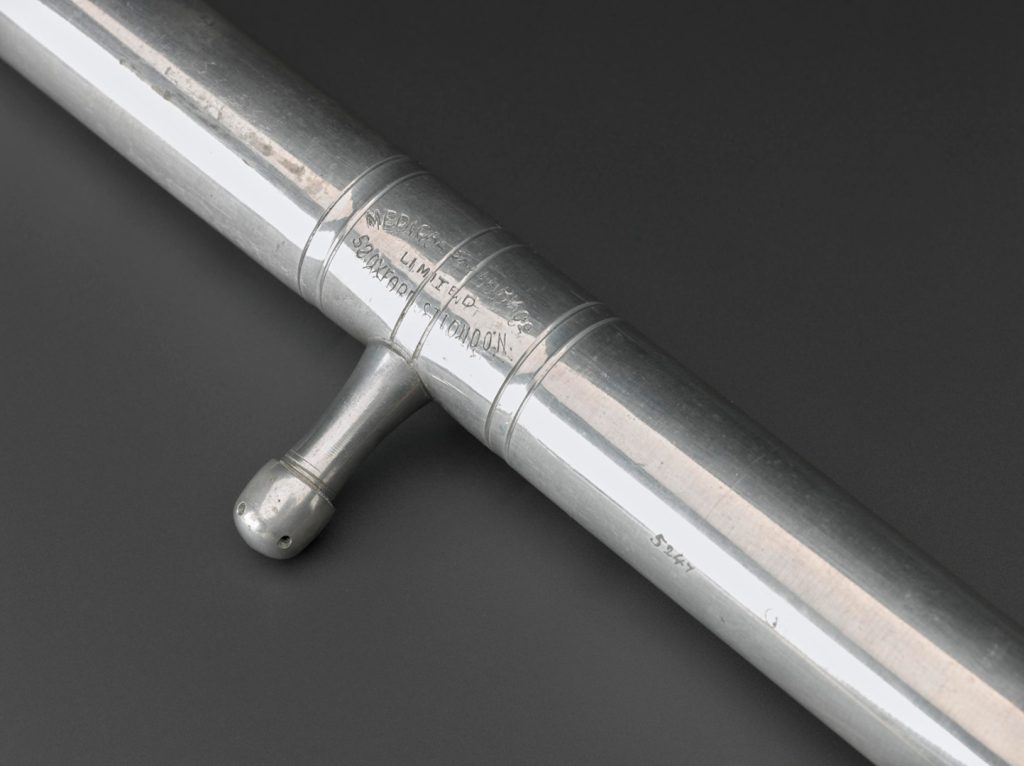
This reactionary relaxation of the throat may account also for the effects of the Ammoniaphone on the young child of an exhausted parent writing in the penny weekly magazine Fun, who declared that the Ammoniaphone was a ‘wonderful invention’:
We tried its effects on our own one-year-old daughter last night. But though the Ammoniaphone sweetened the infant’s screech, we fervently wished the doctor’s invention had been an infant-killing machine. Unfortunately, we gave vent to this desire in words.
1885c, p 262
Although Fun, which had been founded by the actor H J Byron in competition with Punch magazine, revelled in parody and satire, this rather dark piece referencing dreams of infanticide points to the very real dangers in employing an Ammoniaphone to moderate or cultivate the voice. The fervent wish that it had been an infant-killing machine becomes somewhat ironic in light of Lennox Browne’s analysis. Given that the contents of this long silver tube were primarily caustic free ammonia, it is not surprising that this gas would alter or even silence the screams of a young child by inducing relaxation of the throat and that it may even prove fatal. Such punishing treatment would have lasting, potentially disastrous effects on young and old users alike.
Ultimately, and rather predictably, Mackenzie and Browne (as well as many musical and medical magazines) agreed that the superiority of Italian singing was the result not of the air, nor the general climate, nor the evolution of the human race, but an unquestionable pre-eminence in vocal training, known as the ‘old Italian school’ bel canto tradition enjoyed by Italian singers. Emerging in the sixteenth and seventeenth centuries and reaching its zenith in the Romantic era operas of Rossini, Donizetti and Bellini, this singing technique was characterised by pure legato sounds, agility of voice, and fluid vocal embellishments. In this school, the voice was developed gradually over a long period of training, with extensive exercises in proper breathing, diction, the opening of vocal cavities, the projection of tone, and the correct execution of vocal ornaments. Pupils listened to their voice masters’ proper execution of vocalisations and attempted to emulate them, while teachers informed their students when they had attained the desired result and insisted that they memorise and remain alert to the physical and emotional sensations that accompanied the correct technique.[7] In contrast, the modern singing methods frequently employed in English vocal training, drawn from scientific research greatly aided by the Spanish vocalist Manuel Garcia’s invention of the laryngoscope, sought to train the voice more rapidly through a physiologically informed education and complex technical instruction. The strengths and weaknesses of each method were hotly debated in the medical and musical press throughout the nineteenth century – and in fact continue to be analysed in vocal pedagogy today (Miller, 1997). Many writers admitted that the old Italian school was aided by the fact that Italian was a far more melodic language than English, French, or German, as the majority of Italian words terminate in a pure vowel and the sibilants are very soft. Non-Italian vocalists were frequently urged to study Italian as the language of song. In his study, Modern Singing Methods: Their Use and Abuse (1885), the American vocalist John Franklin Botume advocated for an amalgamation of these two methods, insisting that one of the greatest strengths of the Italian school was its regiment of developing the voice over a long period of time:
The teacher of the future will […] follow the old process. He will attempt little the first or the second year, and will go gradually, carefully, regularly and, above all, slowly to the end. […] Nature is a hard task-mistress. When you steal from her today, she will exact with compound interest tomorrow. The end of these ‘short-cuts’ is, that every quick result which the pupil gains is attended either with some physical weakness or disease, or else with an accompanying fault; such as a tremolo, a tendency to sing ‘off the key’, a nasal, sharp, foggy, hard or weak tone, a lack of flexibility, a premature decay of the voice, or some other disagreeable thing.
(Botume, 1885), pp 81–82
There were, medics and vocal pedagogues agreed, no artificial substitutes or quick fixes for dedicated study and extensive vocal training. Further, as the Illustrated Sporting and Dramatic News rather derisively declared in its piece on ‘Nostrums for Vocalists’, the Ammoniaphone belonged only to those ‘feeble folk, who think that a royal road to success may be discovered with the aid of money’ (1885b, p 7). Musical talent was not a simple commodity to be bottled and sold. W Mattieu Williams similarly insisted that within the Italian musical profession, ‘years of steady daily drudgery are devoted to such preparation, with corresponding results’. The Ammoniaphone, he implied, was a product of and for those feeble folk, English artistes who are ‘usually very lazy, and depend upon the natural excellence of their voices rather than upon the daily drill which really has the effect attributed by Dr Moffat to peroxide of hydrogen’ (Williams, 1884, p 406). The only tangible and lasting benefit that may have been derived from purchasing an Ammoniaphone, then, was the inclusion of Moffat’s directions for exercising the voice after inhaling from the instrument, which critics noted would have been valuable even without his wonderful new device.
In the latter decades of the nineteenth century, it was difficult to open a newspaper without being bombarded by a range of advertisements for various nerve remedies and quack medicines, purporting to cure all manner of ills induced by the wear and tear of modern life. In an article written for the literary and political periodical Arena in 1894, the American artist and philosopher Elbert Hubbard identified ‘A New Disease’ that he believed was emerging as a penalty of the progress of modern civilisation. The ‘latest thing in neurotics is paranoia’, Hubbert declared, and it was a condition that he insisted was being deliberately fostered by the endless schemes for self-treatment that were being ‘thrust at us from the columns of every daily’, seen in shop windows in ‘dainty little push boxes containing hypodermic outfits’ and ‘rail announcements of “the only sarsaparilla” and “the kind that cures”’, and ‘pepsin, hypophosphates, bromide, cocaine, chloral are sold on every hand’ (Hubbard, 1894, p 77). Such an overabundance of nerve tonics and remedies, Hubbard added, paradoxically worked on the mind of the observer in order to incite the kind of fear and nervousness that they purported to prevent. Like so many of its counterparts, Carter Moffat’s Ammoniaphone was a quack medical remedy that employed new networks of advertising and the penny post to provoke and to respond to medical and professional anxieties of the age. Exploiting contemporary notions of British singers’ inherent biological, physiological, and even geographical inferiority to their Italian counterparts, the Medical Battery Company’s marketing strategy served to stimulate anxiety within the musical profession while offering a very simple means of relief – for a certain price.
Such unscrupulous tactics and commodified cures for modern ills cannot, however, simply be relegated to the past as mere historical curiosities. Rather, they draw our attention to parallels between the commodity culture of the nineteenth century, and current explorations of the problems and suggested cures of modernity and encourage us to exercise a greater degree of analysis and scepticism. As recently as February 2016, it was revealed that a family business in Dorset has started bottling and selling English countryside air at £80 a bottle to Chinese connoisseurs who, according to the company’s PR savant, will ‘pick up different notes of grass, or near the sea…some saltiness in it as well’ (Robbins, 2016). The video in this Sky News article shows the process of air harvesting. It also shows that if you have a clever marketing strategy, you really need nothing else at all.
Acknowledgments
The research leading to these results has received funding from the European Research Council under the
European Union’s Seventh Framework Programme ERC Grant Agreement number 340121, as well as a Higher Education Innovation Fund Award from the University of Oxford, which allowed me to spend two months researching the medical collections of the London Science Museum, including their collection of Ammoniaphones.
Tags
Footnotes
Back to text
Back to text
Back to text
Back to text
Back to text
Back to text
Back to text

